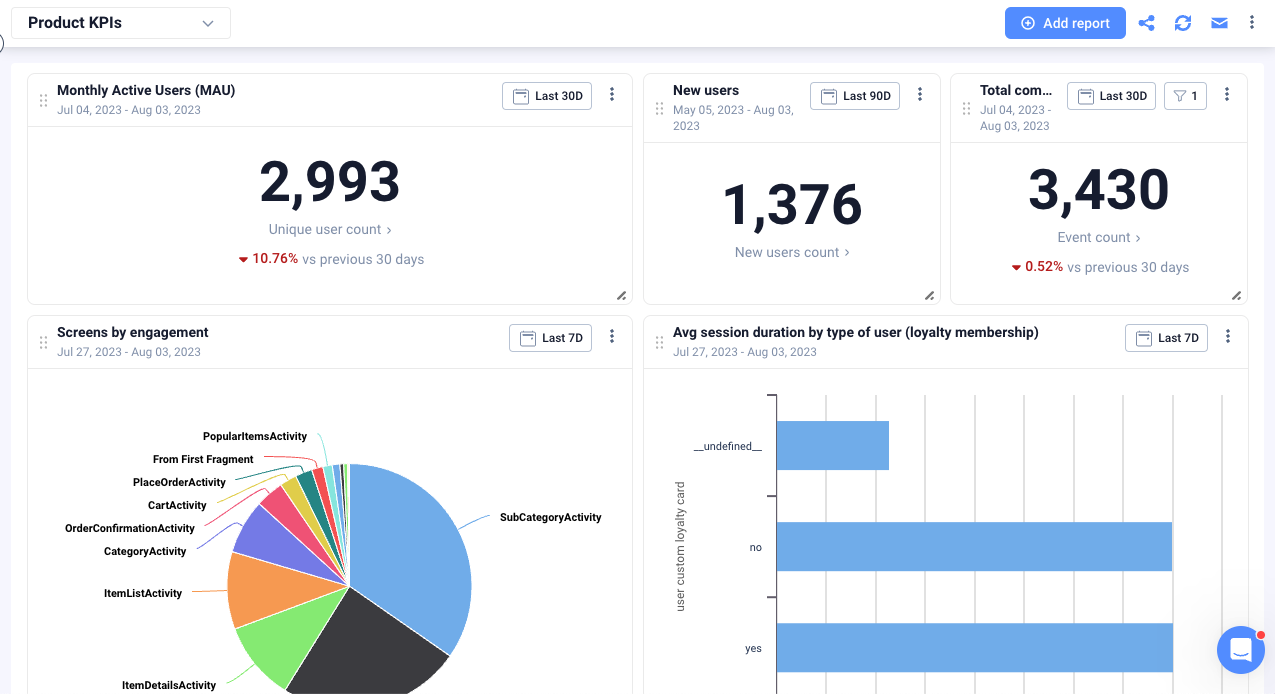Top 11 Product Management KPIs to Track - 2025 Guide
PUBLISHED
18 November, 2024

Growth Marketing Manager
Understanding and tracking product management KPIs is important for any mobile app product team. It’s not just about creating a great user experience, it’s about ensuring that the product delivers value, meets business objectives, and achieves market success.
In this UXCam guide, we will delve into the importance of product management KPIs, how to track them effectively, and why this is a must-know topic for product teams—not just UX teams.
Let’s get started.
Key Product KPIs to track
| Product Management KPI | Description |
|---|---|
| Monthly Recurring Revenue (MRR) | How much money your product is generating on a recurring basis. |
| Customer Satisfaction (CSAT) | How satisfied customers are with your product. |
| Trial Drop-off Rate | How many users who sign up for your trial don't convert to paying customers. |
| Average Revenue Per User (ARPU) | How much revenue each user generates. |
| Customer Acquisition Cost (CAC) | How much it costs to acquire a single customer. |
| Net Promoter Score (NPS) | How likely your customers are to recommend your product. |
| Customer Lifetime Value (CLTV) | How much a customer is worth over their lifetime with your product. |
| Daily/Monthly Active User Ratio (DAU/MAU Ratio) | The ratio of how many users are active on a daily and monthly basis. |
| Session Duration | How much time a user spends on your product. |
| Time to First Respond | How long it takes for customer support to respond to a query. |
| Retention Rate | How many customers stick with your product over time. |
By tracking these KPIs, product teams can gain valuable insights into their product’s performance, user engagement, and market position. This data can guide strategic decision-making and help teams optimize their product for success.
What are product management KPIs?
Let’s start more simply—what is product management? It’s the practice of managing a product’s development process, including research, design, testing, and launching.
Product management key performance indicators (KPIs) are measurable values that product managers use to make sure that their decisions are driving the desired results.
For example, Housing.com’s product manager Guarav Jain uses UXCam to validate ideas with real user data. His team collected data on feature usage, user engagement, and purchase activity to identify opportunities for improvement.
We use UXCam to validate our product ideas and test our hypotheses with raw actionable user insights.
Guarav Jain, Lead product manager at Housing.com
As we’ll see, there are all kinds of product management metrics that you can track. The metrics you should be tracking will depend on your product and goals.
Benefits of product management KPIs
Measuring progress
Product management KPIs serve as a yardstick for measuring the progress of a product. They provide quantifiable data that can be used to assess whether the product is on track to meet its objectives. By regularly monitoring these KPIs, product teams can identify trends, track changes over time, and gauge the effectiveness of their strategies.
Alignment with business goals
KPIs make sure that the product’s objectives align with the broader business goals. They help product teams understand how their work contributes to the company’s overall success. This alignment fosters a sense of purpose within the team and promotes a culture of accountability and ownership.
Focus on customer value
Product management KPIs often include metrics related to customer satisfaction, retention, and engagement. These metrics help product teams maintain a customer-centric approach, ensuring that they're creating value for the end-user. By focusing on customer value, product teams can build products that meet business objectives and resonate with users.
Data-driven decision-making
Lastly, Product Management KPIs facilitate data-driven decision-making. They provide objective, quantifiable data that can guide strategic planning and decision-making. This data-driven approach reduces guesswork and bias, leading to more effective and efficient product development.
How to track product management KPIs effectively
Set goals
Match goals with KPIs
Set KPI targets
Choose the right tool and build dashboards
Monitor and analyze changes
Act on insights
1. Set goals
You should never choose KPIs at random. Every element of your tracking plan should be directly tied to a goal you’re actively trying to achieve. We’ll talk more about connecting KPIs to goals in a moment—for now, think about the big picture.
What are you trying to accomplish with your product?
Product management goals can span from increasing conversions to boosting user engagement and more. Don’t worry about being concrete yet—just capture the gist of what you’re working towards.
For example:
Increasing the amount of time users spend on the platform.
Improving the onboarding flow.
Winning a bigger market share.
Reducing the workload of our support team.
There’s no “right” number of goals, but try to keep it focused. We recommend sticking to seven or fewer.
2. Match goals with KPIs
Now it’s time to give your goals a measurable aspect by pairing them with relevant KPIs. These metrics will help you track progress toward your goals in an actionable way so that you can make strategic decisions and measure success.
For example:
Goal: Increasing the amount of time users spend on the platform.
KPI: Average time per session.
Or:
Goal: Improving the onboarding flow.
KPIs: Trial drop-off rate, retention rate, churn rate, etc.
In some cases, there may be only one KPI that relates to a goal, and in others there may be many. It’s important to choose the right ones and make sure they're tracking the progress you want to make.
3. Set KPI targets
Once you have a selection of product management KPIs, you can start setting targets. Try to keep them specific, measurable, achievable, relevant, and timely (or “SMART”) to get the most out of them.
Start by collecting data on your baseline performance for every metric you want to track. You can then use these figures to set realistic targets and measure your progress over time. Then set targets based on the improvement you need to see to achieve a specific goal.
4. Build product management KPI dashboards
Next, it’s time to build dashboards that will help you monitor your KPIs without needing to go hunting for insights.
Most monitoring and analytics tools will have some kind of built-in dashboard functionality. Use this to design effective visualizations of your KPIs over time or against other metrics, which will provide a more holistic view of product performance.
For example, here’s a mobile product analytics dashboard built in UXCam.

The UXCam dashboard builder allows you to create custom charts, tables and graphs that automatically update as new data is collected. You can also add pre-built reports to get a more complete picture. And since it’s a modular system, you can resize and move each element to prioritize the information most relevant to your goals.
For web-based products, there are dedicated tools available like:
Mixpanel
Google Analytics
Hotjar
5. Monitor and analyze changes
With your dashboard(s) set up, you can now monitor and analyze changes in product behavior. Look for trends or patterns that could be indicative of a larger problem using event analytics and heatmaps. Zoom in on an individual user’s experience and behavior with session replays and user journey mapping to define issues and brainstorm solutions.
Also, be sure to incorporate A/B testing into your workflow, so you can track the impact of changes (or lack thereof) on user engagement over time.
6. Act on insights
Finally, use the data and insights you’ve gathered to inform strategies for improvement. Test hypotheses, run experiments with users, and deploy changes based on data-driven decisions.
The goal is to continuously seek out ways to improve user experience and optimize product performance. Your analytics dashboard should be used as a tool to measure success, not just collect data. Use what you learn to inform product decisions and iterate on user experience.
Conclusion
Tracking product management KPIs is essential for delivering successful products that meet customer needs and business goals. By measuring the right metrics, you can align your team, prioritize your roadmap, and communicate your progress and impact.
UXCam is a mobile product analytics tool that helps product managers measure usage, engagement, and more. Use UXCam to get real-time insights on how users interact with your product and adjust your roadmap accordingly.
Try UXCam for free today.
You might also be interested in these;
Product management KPI dashboard examples & how to use them
How to analyze session recordings
Product analytics dashboard examples (+ how to use them)
12 Best product management tools 2024 & when to use them
8 Important product management templates for mobile app teams
Product management and user experience - How to collaborate effectively
AUTHOR

Tope Longe
Growth Marketing Manager
Ardent technophile exploring the world of mobile app product management at UXCam.
Get the latest from UXCam
Stay up-to-date with UXCam's latest features, insights, and industry news for an exceptional user experience.
Related articles
Session Replay
Mobile Session Recording: The Complete Guide 2025
Why session replay is such a valuable feature, and what you should look out for when starting...

Annemarie Bufe
Content Manager
Product Management
Top 11 Product Management KPIs to Track - 2025 Guide
Master product management with our guide on the top 11 KPIs for tracking product adoption strategy, essential for informed...

Tope Longe
Growth Marketing Manager
Product Management
A Practical Guide to Mobile App Product Management
How is the increase in mobile use changing the landscape of the product management role, and what are the differences between traditional product management and mobile product...


